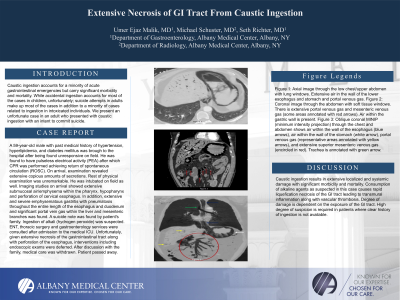Sunday Poster Session
Category: Esophagus
P0470 - Extensive Necrosis of the GI Tract From Caustic Ingestion
Sunday, October 22, 2023
3:30 PM - 7:00 PM PT
Location: Exhibit Hall

Has Audio

Umer Ejaz Malik, MD
Albany Medical Center
Albany, NY
Presenting Author(s)
Umer Ejaz Malik, MD, Michael Schuster, MD, Seth Richter, MD
Albany Medical Center, Albany, NY
Introduction: Caustic ingestion accounts for a minority of acute gastrointestinal emergencies but carry significant morbidity and mortality. While accidental ingestion accounts for most of the cases in children, unfortunately; suicide attempts in adults make up most of the cases in addition to a minority of cases related to ingestion in intoxicated individuals. We present an unfortunate case in an adult who presented with caustic ingestion with an intent to commit suicide.
Case Description/Methods: A 59-year-old male with past medical history of hypertension, hyperlipidemia, and diabetes mellitus was brough to the hospital after being found unresponsive on field. He was found to have pulseless electrical activity (PEA) after which CPR was performed achieving return of spontaneous circulation (ROSC). On arrival, examination revealed extensive copious amounts of secretions. Rest of physical examination was unremarkable. He was intubated on field as well. Imaging studies on arrival showed extensive submucosal air/emphysema within the pharynx, hypopharynx and perforation of cervical esophagus. In addition, extensive and severe emphysematous gastritis with pneumatosis throughout the entire length of the esophagus and duodenum and significant portal vein gas within the liver and mesenteric branches was found. A suicide note was found by patient's family. Ingestion of alkali (hydrogen peroxide) was suspected. ENT, thoracic surgery and gastroenterology services were consulted after admission to the medical ICU. Unfortunately, given extensive necrosis of the gastrointestinal tract along with perforation of the esophagus, interventions including endoscopic exams were deferred. After discussion with the family, medical care was withdrawn. Patient passed away.
Discussion: Caustic ingestion results in extensive localized and systemic damage with significant morbidity and mortality. Consumption of alkaline agents as suspected in this case causes rapid liquefication necrosis of the GI tract leading to transmural inflammation along with vascular thrombosis. Degree of damage is dependent on the exposure of the GI tract. High degree of suspicion is required in patients where clear history of ingestion is not available.

Disclosures:
Umer Ejaz Malik, MD, Michael Schuster, MD, Seth Richter, MD. P0470 - Extensive Necrosis of the GI Tract From Caustic Ingestion, ACG 2023 Annual Scientific Meeting Abstracts. Vancouver, BC, Canada: American College of Gastroenterology.
Albany Medical Center, Albany, NY
Introduction: Caustic ingestion accounts for a minority of acute gastrointestinal emergencies but carry significant morbidity and mortality. While accidental ingestion accounts for most of the cases in children, unfortunately; suicide attempts in adults make up most of the cases in addition to a minority of cases related to ingestion in intoxicated individuals. We present an unfortunate case in an adult who presented with caustic ingestion with an intent to commit suicide.
Case Description/Methods: A 59-year-old male with past medical history of hypertension, hyperlipidemia, and diabetes mellitus was brough to the hospital after being found unresponsive on field. He was found to have pulseless electrical activity (PEA) after which CPR was performed achieving return of spontaneous circulation (ROSC). On arrival, examination revealed extensive copious amounts of secretions. Rest of physical examination was unremarkable. He was intubated on field as well. Imaging studies on arrival showed extensive submucosal air/emphysema within the pharynx, hypopharynx and perforation of cervical esophagus. In addition, extensive and severe emphysematous gastritis with pneumatosis throughout the entire length of the esophagus and duodenum and significant portal vein gas within the liver and mesenteric branches was found. A suicide note was found by patient's family. Ingestion of alkali (hydrogen peroxide) was suspected. ENT, thoracic surgery and gastroenterology services were consulted after admission to the medical ICU. Unfortunately, given extensive necrosis of the gastrointestinal tract along with perforation of the esophagus, interventions including endoscopic exams were deferred. After discussion with the family, medical care was withdrawn. Patient passed away.
Discussion: Caustic ingestion results in extensive localized and systemic damage with significant morbidity and mortality. Consumption of alkaline agents as suspected in this case causes rapid liquefication necrosis of the GI tract leading to transmural inflammation along with vascular thrombosis. Degree of damage is dependent on the exposure of the GI tract. High degree of suspicion is required in patients where clear history of ingestion is not available.

Figure: Figure 1: Axial image through the low chest/upper abdomen with lung windows. Extensive air in the wall of the lower esophagus and stomach and portal venous gas. Figure 2: Coronal image through the abdomen with soft tissue windows. There is extensive portal venous gas and mesenteric venous gas (some areas annotated with red arrows). Air within the gastric wall is present. Figure 3: Oblique coronal MINIP (minimum intensity projection) through the chest and abdomen shows air within the wall of the esophagus (blue arrows), air within the wall of the stomach (white arrow), portal venous gas (representative areas annotated with yellow arrows), and extensive superior mesenteric venous gas (encircled in red). Trachea is annotated with green arrow.
Disclosures:
Umer Ejaz Malik indicated no relevant financial relationships.
Michael Schuster indicated no relevant financial relationships.
Seth Richter indicated no relevant financial relationships.
Umer Ejaz Malik, MD, Michael Schuster, MD, Seth Richter, MD. P0470 - Extensive Necrosis of the GI Tract From Caustic Ingestion, ACG 2023 Annual Scientific Meeting Abstracts. Vancouver, BC, Canada: American College of Gastroenterology.
